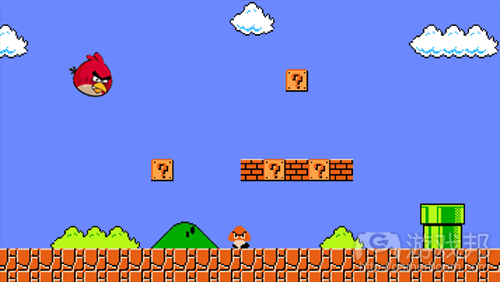评宫本茂对《愤怒的小鸟》的错误看法
作者:Chris Schilling
我曾经将《愤怒的小鸟》的流行视为一个浩劫后情境,即99%的粉丝因神秘的传染机制而深中小鸟之毒,剩下一小部分群体却奇迹般地没有受到感染。可以说《愤怒的小鸟》的病毒式传播与YouTube上那只小猫弹钢琴的视频一样极具传染性。人们玩这款游戏是因为好友在玩它,是因为名人在讨论它,是因为它已经变成一种最新的文化现象。
当然了,这并不是一种新的游戏现象,我们也能够在任天堂的游戏中找到共同点。如Game Boy上的《俄罗斯方块》便是那个时代最普及的一款游戏;Wii Sports为玩家开启了新的媒介,后来将更多用户带到智能手机和浏览器游戏上——而这两种媒介都有Rovio这款大受欢迎的益智游戏的不同版本。
正是因为考虑到这一点,我们才会对宫本茂大加赞赏《愤怒的小鸟》这一态度感到吃惊。他在采访中说道“我之所以喜欢《愤怒的小鸟》是因为它不仅具有传统电子游戏的特质,同时它还拥有创新性。我们能够从游戏中感受到开发者创造游戏的乐趣。这也正是我欣赏这款游戏的重要原因。”
听到如此评价后,我便决定开始研究为何《愤怒的小鸟》能够吸引像宫本茂这样的设计师。游戏的即时性应该是一大优势,而传染性也是功不可没。尽管小鸟和绿猪彼此看起来并不像是敌人,但是它的确需要像这种卡通角色去传达基本目标。游戏的基本关卡,也就是它那受物理驱动的破坏机制与《超级玛丽兄弟》中的Goomba和Koopa Troopa极为相似。而它的角色设计所具有的即时吸引力也充满了任天堂游戏风格。尽管在《愤怒的小鸟》中,小鸟并没有马里奥和他的敌人那种功能设计特质——虽然营本茂最著名的设计取决于其局限性,但这些角色仍具有普遍吸引力。
如果说开发者是带着乐趣创造《愤怒的小鸟》这款游戏,那也是建立在牺牲玩家的基础之上。它的这种反复尝试玩法,意味着你很可能是在偶然情况下闯过一关。《马里奥赛车》等游戏也拥有一些随机元素,游戏中的blue shell便是一种能够让新手玩家战胜资深对手的有利设备。的确,可能因为Wii摇控器天生的不严密性让宫本茂愿意牺牲精确度以换取易用性,但是《愤怒的小鸟》物理性质上的不一致性(即在两次完全相同的回合中,却可能出现败胜不一的结果)却是我们认为宫本茂所不能容忍之处。
任天堂也不曾在游戏中引入像“Mighty Eagle”(游戏邦注:《愤怒的小鸟》付费道具)这种元素。乍看之下Rovio的关卡忽略功能与任天堂的“Super Guide”(动态帮助系统)没有多大的区别,但是实际上后者能够进一步推动玩家前进,让他们体验到全部游戏内容。而Rovio则更希望从玩家身上获得盈利。在去年的GDC智能手机峰会上Rovio首席营销官Peter Vesterbacka便声称他希望50%的玩家购买Mighty Eagle功能——而这也能很好地解释为何《愤怒的小鸟》的难度曲线会如此不稳定。简单地说,也就是这款游戏的玩家如果不借助任何帮助便很难走到游戏最后。
换句话说,《愤怒的小鸟》与任天堂游戏一点都不像,而这就更难解释为何宫本茂会喜欢这款游戏了。也许他的赞赏只是因为这款游戏获得了广泛的用户群体。在他与Hookshot的对话中我们也更是意识到其中的一点羡慕心理,他承认“我当然希望自己能够最先想出这个具有说服力和吸引力的游戏理念。”
而根据宫本茂自己的描述,他并“没有太多时间”去玩手机游戏,这就意味着他对App Store还不是很熟悉;而对于我们这些每周都会浏览App Store的人来说,《愤怒的小鸟》的游戏理念真的没有多大新意(尽管它真的取得了巨大的成功)。
(本文为游戏邦/gamerboom.com编译,拒绝任何不保留版权的转载,如需转载请联系:游戏邦)
Opinion: Why Miyamoto is wrong about Angry Birds
Chris Schilling
I once likened the ubiquity of Angry Birds to that familiar post-apocalyptic scenario where 99% of the population has fallen victim to a mysterious virus while the remaining few are miraculously unaffected. By happy accident I was led to the revelation that Angry Birds was indeed viral: a ludic contagion equivalent to a YouTube video of a cat playing a piano. People played Angry Birds because their friends were playing it, because celebrities were discussing it; because it was the latest cultural touchstone about which everyone had to have an opinion.
Of course, this isn’t a new phenomenon in games; indeed, it’s one Nintendo in particular is very familiar with. Game Boy’s Tetris was the must-play game of its time; Wii Sports opened up the medium to a new audience, only for much of that market to migrate to smartphone and browser games – two formats which, of course, both host versions of Rovio’s ubiquitous physics-puzzler.
With that in mind, it came as quite a shock to hear that Shigeru Miyamoto had lavished praise on the game in a recent interview. “What I like about Angry Birds is that it has a traditional videogame [feel] to it, but also a very creative side,” he told Edge in Paris last week. “And you can really feel that they’re having fun developing the game. That’s what I like about it.”
After the initial surprise at his comments had worn off, I began to see why Angry Birds might appeal to a designer like Miyamoto. Its immediacy is an obvious strength, as is the communicability of its conceit. Birds and pigs might not seem like the most natural of enemies, but it barely needs those comic-book panels to convey its basic objective. And on a base level, its physics-powered destruction carries the same childlike joy as scattering Goombas and Koopa Troopas with a Starman. The instant appeal of its character design, too, is very Nintendo. The birds may not have been born of the functional design ethos that informed the creation of Mario and his enemies – though Miyamoto’s most famous designs were partly defined by their limitations – but their appeal is similarly universal.
Yet if the developers had fun making Angry Birds, it often seems to come at the expense of the player. Its trial-and-error systems mean you’re often as likely to complete a level by accident as design. Games like Mario Kart have historically had random elements, but those blue shells are a way to level the playing field, a device to give novices and youngsters a shot at victory against more skilled opponents. You could argue that the natural imprecision of the Wii remote suggests that Miyamoto is now happy to sacrifice accuracy at the altar of accessibility, but the inconsistencies of Angry Birds’ physics – two seemingly identical turns can result in success on one attempt, failure the next – is not something you could imagine Miyamoto standing for.
Nor would you ever see Nintendo introducing something as baldly cynical as the Mighty Eagle. At first glance, Rovio’s level-skip feature wouldn’t seem to be too different from Nintendo’s own Super Guide, but the latter’s inclusion is to help struggling players progress so that they might see the whole game. Rovio simply wants to further monetise its users. At the GDC Smartphone Summit last year, Rovio CEO Peter Vesterbacka claimed that he wanted 50 per cent of players to purchase the Mighty Eagle, which goes some way to explaining Angry Birds’ erratic difficulty curve. Put simply, your average player is not supposed to reach the end unassisted.
In other words, Angry Birds isn’t a very Nintendo-like game at all – which only serves to make Miyamoto’s stance more unlikely. Perhaps his praise stems from a simple desire to reach as wide an audience as possible. There’s a hint of envy in there, too, in his admission to Hookshot that he wished he “had been the one to come up with the idea first… [because] obviously I want to be the one creating the most convincing, surprising game ideas.”
Yet by his own admission, Miyamoto doesn’t “have a lot of time” to play mobile games, which suggests his experience of the App Store is limited; those of us who do browse the App Store on a weekly basis will surely concur that Angry Birds is neither the most convincing nor surprising idea, even if it is the most successful.
The truth, then, is that Miyamoto probably couldn’t have conceived Angry Birds. While shareholders might wish otherwise – 600 million downloads and tens of millions of soft toy sales would be just the ticket for Nintendo’s ailing finances – Miyamoto shouldn’t lose sleep over the fact he didn’t think of it first.(source:edge-online)
上一篇:阐述游戏不需要成为艺术的5大理由








































 闽公网安备35020302001549号
闽公网安备35020302001549号